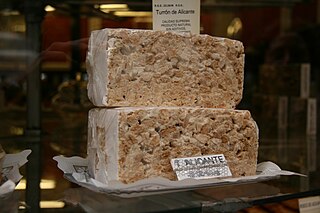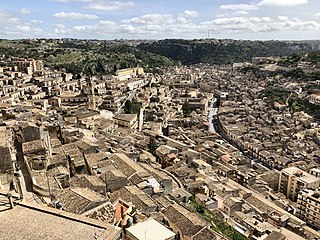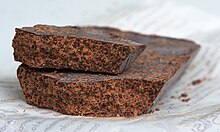
Turrón, torró or torrone is a Mediterranean nougat confection, typically made of honey, sugar, and egg white, with toasted almonds or other nuts, and usually shaped either into a rectangular tablet or a round cake. Turrón is usually eaten as a dessert food around Christmas in Spain and Italy. In Malta it is sold in street stalls as qubbajd during the parish patron saint feast of the various localities.

Fettuccine Alfredo is a pasta dish consisting of fettuccine tossed with butter and Parmesan cheese, which melt and emulsify to form a rich cheese sauce coating the pasta. Originating in Rome in the early 20th century, the recipe is now popular in the United States and other countries. Outside of Italy, cream is sometimes used to thicken the sauce, and ingredients such as chicken, shrimp, salmon or broccoli may also be added when it is served as a main course.

Hot chocolate, also known as hot cocoa or drinking chocolate, is a heated drink consisting of shaved or melted chocolate or cocoa powder, heated milk or water, and usually a sweetener. It is often garnished with whipped cream or marshmallows. Hot chocolate made with melted chocolate is sometimes called drinking chocolate, characterized by less sweetness and a thicker consistency.
White chocolate is a form of chocolate made of cocoa butter, sugar and milk. Unlike milk and dark chocolate, it does not contain cocoa solids, which darken the chocolate. White chocolate has an ivory color, and can smell of biscuit, vanilla or caramel, although it can also easily pick up smells from the environment and become rancid with its relatively short shelf life. Like milk and dark chocolate, white chocolate is used to make chocolate bars and as a coating in confectionery.

Pizzoccheri (Italian:[pitˈtsɔkkeri]; Lombard: pizzòcher a flat ribbon pasta, made with a blend of buckwheat flour and wheat flour. It is believed to have originated in Valtellina, a valley in the northern Italian region of Lombardy. It is also popular in Val Poschiavo, a side valley of Valtellina which belongs to the Swiss canton of Grisons.

Modica is a city and comune of 54,456 inhabitants in the Province of Ragusa, Sicily, southern Italy. The city is situated in the Hyblaean Mountains.

Swiss chocolate is chocolate produced in Switzerland. Switzerland's chocolates have earned an international reputation for high quality with many famous international chocolate brands.

Cailler is a Swiss chocolate brand and production factory based in Broc. It was founded in Vevey by François-Louis Cailler in 1819 and remained independent until the early 20th century, when it associated with other producers. Shortly before, Cailler opened its main factory at Broc in 1898. The company was finally bought by Nestlé in 1929 and became a brand. Cailler is the oldest chocolate brand still in existence in Switzerland.

Gianduja or gianduia is a homogeneous blend of chocolate with 30% hazelnut paste, invented in Turin during Napoleon's regency (1796–1814). It can be consumed in the form of bars or as a filling for chocolates.

Affogato, known in full in Italian as affogato al caffè and gelato affogato al caffè, is an Italian dessert comprising a scoop of gelato or ice cream, either plain milk-flavored or vanilla, topped with hot espresso. Some variations add a shot of amaretto, bicerin, Kahlúa, or other liqueur.

Chocolate salami is an Italian and Portuguese dessert made from cocoa, broken biscuits, butter and sometimes alcohol such as port wine or rum. The dessert became popular across Europe and elsewhere, often losing alcohol as an ingredient along the way.

Caffarel is a chocolate-manufacturing company based in Luserna San Giovanni, Italy, which is a subsidiary of Lindt & Sprüngli. The company was founded in Turin during the 19th century. According to the company, it was founded in 1826 when Pierre Paul Caffarel (1801–1871) converted an ex-tannery into a chocolate factory and invented Gianduiotto in 1852.

Massimo Bottura is an Italian chef, gastronome and entrepreneur.
Torta setteveli is a seven-layer cake. Traditionally served at birthdays, it includes chocolate and hazelnuts. It is traditionally served at birthday parties in Palermo, Sicily.
The Antica Dolceria Bonajuto is a chocolate factory founded in Modica in 1880, known to be the oldest in Sicily and one of the oldest in Italy and for having been frequented by illustrious people of international fame.

Alprose is a Swiss chocolate producer based in Caslano (Ticino). It was founded in 1957 under the name Titlis SA and received its current name in 1983.

§The Fabbrica di Cioccolato CimaNorma S.A., also Chocolat Cima-Norma S.A., in Dangio- Torre was an industrial chocolate production company in the canton of Ticino. It was founded in 1903 by the Cima brothers and closed its doors in 1968. The company CimaNorma S.A. also stands for the economic development and modernization advancement goal from the beginning of the 20th century for the mountain valley Blenio Valley, which was classified as a peripheral region.

The Siracusa–Gela–Canicattì railway is a single-track line in Sicily, Italy managed by RFI. The route connects Syracuse on the Ionian side of Sicily to the Mediterranean side, crossing, with an east-west route, a number of large urban centers to Canicattì.

Salvatore Farina is an Italian essayist, cultural researcher, teacher and photographer.


















